Wildlife and Grazing: Birds and Herds
Grazing Season of Use Effects on Sagebrush-obligate Songbirds
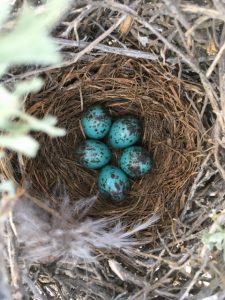
Population declines of sagebrush-obligate birds, including Brewer’s sparrow, greater sage-grouse, sagebrush sparrow, and sage thrasher, have occurred since the 1950’s in the Great Basin. While not a primary threat, livestock grazing is the predominant use of sagebrush habitat. However, there is no published literature from a rigorous comparison of direct or indirect effects of livestock grazing on sage-grouse or sagebrush-obligate songbirds.
- Status: We are currently in the process of analyzing data for the full five years of the study, which includes one year of pre-treatment data (2017) and four years post-treatment data (2018-2021), and we anticipate several publications. One publication has been published for the short term effects of grazing (1 year pre-treatment and 2 years post-treatment)
- Anticipated publications:
- How Does Cattle Grazing Affect the Nest Predator Community of Sagebrush-obligate Songbirds?
- Moderate term effects of moderate rotational cattle grazing on sagebrush-obligate songbirds
- Habitat selection of sagebrush-obligate songbirds
- Completed publications:
- Weather explains differences in sagebrush-obligate songbird nest success under various grazing regimes (click button below to read)
Completed MS thesis (click to access resources):
A Rangeland Mosaic: Sage-grouse, Cattle, and Predators
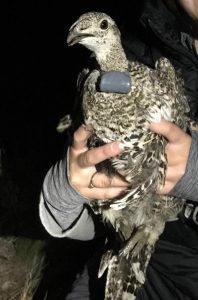
Very little is known about potential benefits or threats of livestock grazing on sage-grouse habitat and populations. This project, located in Wyoming, is investigating how cattle presence on the landscape may affect local mammalian and avian sage-grouse predators. It is suspected that there may be some indirect interactions between livestock and avian predators, which may differ from interactions between livestock and mammalian predators. For example, some unpublished data out of Wyoming suggests higher golden eagle and raven abundances near pastures with domestic sheep.

- Status: Currently collecting data in the Bighorn Basin in Wyoming including:
- Capturing and collaring sage-grouse hens
- Quantifying predators with avian predator point counts and transects
- Deploying camera traps to monitor cattle and mammalian predator presence
- Monitoring cattle with GPS and presence with patty counts
Wildlife at Risk
Influence of Weeds, Fire, and Ravens on Sage-Grouse in Baker and Malheur counties
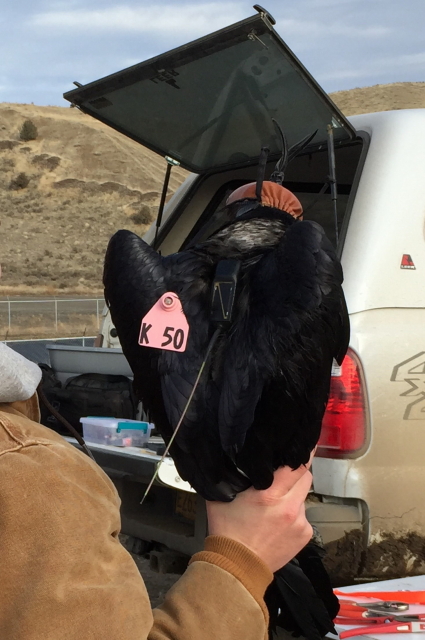
Federal, private, and state stakeholders are concerned that high raven density has contributed to sage-grouse decline in the Baker Sage-grouse Priority Area for Conservation (PAC). Thus, we are evaluating sage-grouse and raven interactions in (1) the Baker PAC, where lethal removal of ravens has been proposed, (2) a PAC in Malheur County proposed to have non-lethal manipulation of ravens, and (3) three reference PACs in Malheur County. We are simultaneously assessing the effect of wildfire and invasive annual grasses on sage-grouse habitat use and demographic rates.
- Status: currently
collecting data including:
- Conducting raven and raptor counts in five sage-grouse PACs
- Capturing and tagging sage-grouse in Baker and Malheur counties
- Tracking sage-grouse during summer and winter
- Trapping and tracking ravens across eastern Oregon
Identifying Critical Winter Wildlife Habitat
Identification of Winter Concentration Areas for Sage-Grouse in Wyoming: Abundance and Resource Selection.

Availability and use of winter habitat by sage-grouse can influence populations but is often overlooked when prioritizing areas for sage-grouse conservation. Wyoming has identified the need to delineate winter concentration areas (WCAs), which have been defined as areas with consistently >50 sage-grouse during the winter. This study was designed to detect locations of unknown WCAs while assessing abundance and resource selection to better understand sage-grouse use of winter habitats.
- Status: We have analyzed and published on the use of aerial infrared from a fixed-wing aircraft to estimate resource selection functions for individual sage-grouse and flocks. We are currently working on analyses to estimate how abundance during the winter is influenced by habitat and climatic characteristics.
Wildlife Conservation: The Umbrella Approach
Effectiveness of Sage-grouse as an *Umbrella Species for Sagebrush-obligate Songbirds

Sagebrush habitat management relies heavily on known biology of sage-grouse. However, a knowledge gap persists surrounding the efficacy of sage-grouse as an umbrella species. Comparisons of population trends and reproductive success of sagebrush-obligate songbirds and sage-grouse will greatly inform future conservation actions. At present, there is little published literature on sagebrush-obligate songbird ecology and population status in the western range of the sagebrush biome. Outcomes of this study will help management agencies and private land owners improve sage-grouse habitat and monitor co-occurring sagebrush wildlife.
Status: We are currently analyzing datasets and drafting publications to compare sagebrush-obligate songbird abundance and reproductive success in representative sagebrush habitat and locations used by sage-grouse. Developing important information for modeling including climate and vegetation variables, sage-grouse utilization and predator community information.
Anticipated publications: Evaluating sagebrush-obligate songbird abundance under the greater sage-grouse umbrella; Sagebrush-obligate songbird productivity in relation to greater sage-grouse use vs available locations
Definitions: *Umbrella Species—an umbrella species is defined as a species whose conservation is expected to confer protection to a large number of naturally co‐occurring species.
Sage-Grouse and Predators in “Core” Areas
Habitat Quality of Sage-Grouse Core Areas Relative to Avian and Mammalian Predators.

While human development influences sage-grouse, development also increases subsidies for avian and mammalian predators. High predator abundance can negatively influence sage-grouse demographic rates. Wyoming’s Sage-Grouse Core Area Policy added protections to important habitat for sage-grouse by reducing human development, and Core Areas have maintained higher sage-grouse trends compared to Non-Core Areas. We are comparing predator abundance within and outside Core Areas.
- Status: The graduate student completed her master’s thesis and we are working on submitting publications to peer refereed journals
Wildlife Trends: Human, Environment or Both?
Factors Driving Greater Sage-Grouse Trends in the Eastern Portion of Their Range: Anthropogenic, Fire, Habitat, Hunting, Ravens, and Weather
Degradation of sagebrush habitat has occurred throughout the range of sage-grouse. Areas with greater loss of sagebrush habitat are avoided by sage-grouse and are congruent with lower demographic rates and lek extirpation. We are simultaneously evaluating the relative importance of habitat and potential predation with numerous anthropogenic, fire, habitat, hunting regulations, raven numbers, weather factors, and prevalence of West Nile virus on lek trends of sage-grouse populations in the eastern range of sage-grouse.
- Status: Evaluating sage-grouse trends 1995–2014 in four large sage-grouse populations, including Northern Montana, Powder River Basin, Wyoming Basin, and Yellowstone Watershed
Steens Mountain Area Wildlife Habitat Study
Impact of Juniper Expansion and Removal in Aspen and Riparian Areas on Wildlife Species
We have completed year four of a study to understand how juniper removal in aspen, riparian, and sagebrush vegetation types influences sensitive wildlife. We are specifically interested in the impact removal has on mule deer and avian species. The effect of removing juniper on songbirds and mule deer has been previously studied in sagebrush ecosystems, but not in aspen and riparian areas within sagebrush. These areas provide critical resources and support a large diversity of birds despite their relatively small size. Additionally, juniper removal has not been assessed in relation to interactive effects with avian predator abundance. Our project will take the first step in this assessment by gathering data regarding avian predator and habitat relationships. We will also integrate analyses with an ongoing study in Baker and Malheur counties (discussed above) in Oregon. This will increase sample size and interpretations regarding avian ecology in the sagebrush ecosystem. Information from this project will help fill knowledge gaps and inform management decisions.
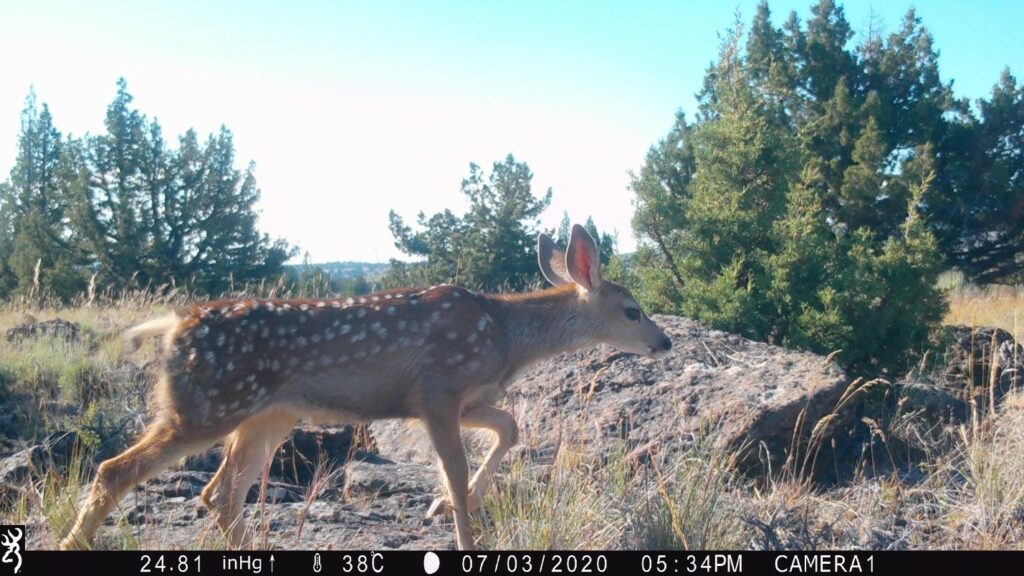

- Status: We have completed year four of data collection (two years of pre-treatment data in 2019 and 2020 and two years of post-treatment data in 2021 & 2022) and year three of juniper removal treatments (2020-2022).
With this data, we hope to:
- Compare abundance of sensitive wildlife species, specifically birds and mule deer, before and after juniper removals associated with aspen, riparian, and sagebrush vegetation
- Evaluate differential avian predator densities across a juniper cover gradient in associated with aspen, riparian, and sagebrush vegetation
- Evaluate changes in avian species richness before and after juniper removals associated with aspen, riparian, and sagebrush vegetation
Avian Predator Occupancy and Diet at Communication Sites in Sage-Grouse Habitat

Studies have shown that sage-grouse avoid tall structures and both transmission lines and cellular towers have been linked to sage-grouse lek abandonment. These structures facilitate nesting and perching of avian predators of sage-grouse and their nests. We are conducting a field study to determine how the design, arrangement, and location of cellular/communication and transmission towers influences nesting and perching of ravens and other avian predators. We are assessing the prey composition of predators nesting at towers by Next-generation genetic sequencing of fecal samples, pellets, and prey items gathered from predator nests. We aim to assess prey composition and to determine the extent to which sage-grouse and/or other sensitive species make up diets of human subsidized avian predators.
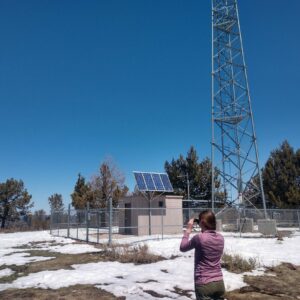
Status: We are in the data collection phase of this multi-year research project.
